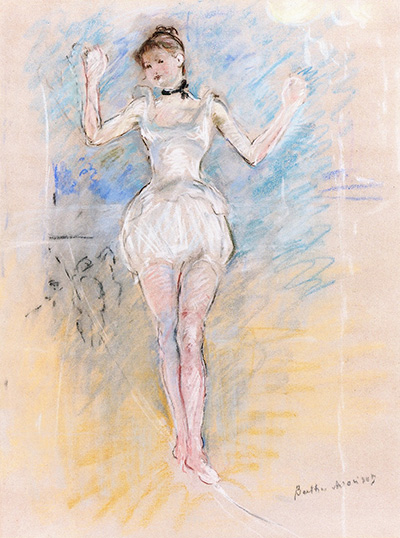Berthe Morisot is most famous for her oil paintings as part of the Impressionist movement, but she was actually involved in a number of mediums including watercolour, pastel, gouache and graphite.
In general terms it was her pastel work which was most complete and presentable as completed artworks, where as her watercolours tended to be lighter and will less detail. She produced many seascape watercolours during her career, normally in batches during visits to the French coast. This light style seemed to suit that genre particularly well. Her pastels were normally of landscapes of the French countryside or domestic scenes. The colour schemes between the two different mediums would be very different, with her pastel work much darker and clearer - the Impressionists in general were keen on using pastels in sketchbooks when travelling around. It was much easier than producing oil paintings outside, which would always require much greater planning ahead of time.
The Morisot drawing captured here is of a young ballet dancer, which will immediately remind us of the Impressionist movement in general, but also specifically the work of Edgar Degas with titles such as Dancer Adjusting her Slipper. He spend years on the theme of ballerinas and will likely always be inseparable from this topic, but Morisot shows here that she was also capable with this type of figurative content. This was more of a temporary change for the artist, though, as she produced many more landscapes and domestic portraits over the span of her career. Indeed, she was pivotal in expressing the lives of women from a different perspective and helping to change the way in which women's role in society was perceived and what was expected.
Morisot would practice her skills of portraiture with pastels. It enabled to work on line and form as well as loosely consider colour as well. Standard graphite work would only do the former, leaving a gap to be bridged between this stage and later oil paintings, where colour choices would become critical to the success of the overall work. She could carry around sketchbooks on her person and quickly put together a series of different experimental drawings in a short space of time. Sometimes she would hire models, other times she would make use of friends and family, many of whom were already involved in the art industry and therefore very understanding and willing to help Berthe continue her studies and development.
Where less time was available, Berthe might use a simple pencil instead and just throw out a few quick line drawings which focused on the key elements of a composition. She might then move on and add charcoal shading into the next piece in a series and slowly, over time, push towards a completely finished oil painting. One issue with her work in this medium is that there has never been a satisfactory study completed, leaving us forced to piece together tit-bits of information from a variety of articles to try to create a comprehensive summary of her work with pastels and pencils. Hopefully, that will change in the future and perhaps some of these items will be pulled together for a large-scale exhibition sometime soon.




